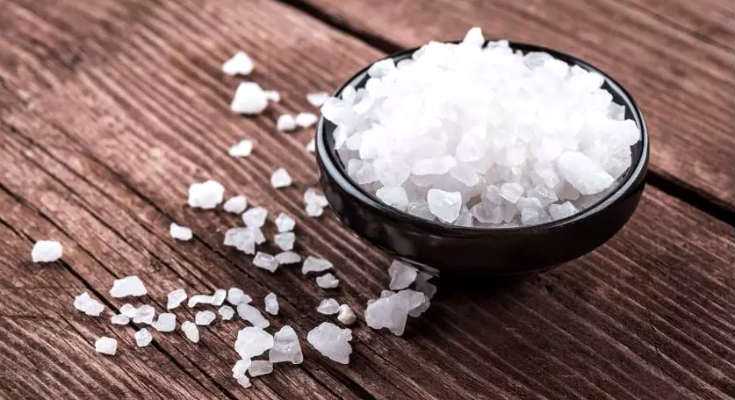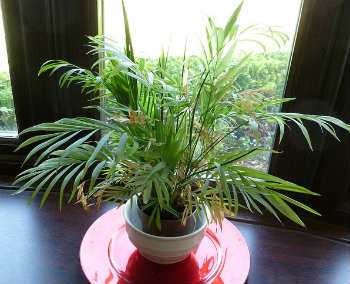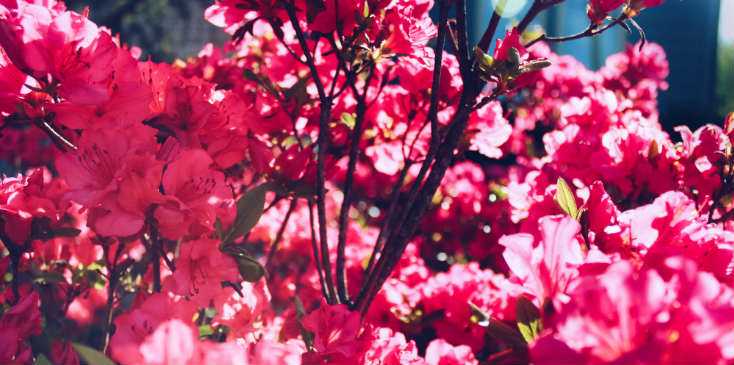Epsom Salt for Palm Trees: Is it Good for Plants?

Palm trees are one of the most easily recognized trees in the world. Although they are indigenous to tropical and subtropical climates, palm trees are popular additions to landscaped areas that do not have heavy frosts, and indoors as potted plants. There are more than 2,500 species of palm trees and all of them are prone to magnesium deficiency if not properly cared for. Epsom salt for palm trees is an excellent source of magnesium.
What is Epsom Salt?
Epsom salt is magnesium sulfate. It gets its name from the wells in Epsom, England where it was first discovered many years ago. In addition to many medicinal uses for Epsom salt, it is also an effective natural fertilizer for many plants and flowers, including palm trees.
To be more precise, Epsom salt is crystalized magnesium sulfate containing 10% magnesium and 13% sulfur. An inorganic salt, it is also known as the heptahydrate sulfate mineral Epsomite.

It is estimated that nearly 3 million tons of Epsom salt is used globally for medicinal and agricultural purposes. Epsom salt is both odorless and water soluble, making it a convenient resource for a variety of uses.
Its properties are important for seed germination and the creation of chlorophyll, which is necessary to the process of photosynthesis. Using Epsom salt for plants strengthens the plant’s cell walls and improves the absorption of vitamins, enzymes, and proteins.
Epsom Salt as Palm Tree Fertilizer
Magnesium sulfate, or Epsom salt, can help maintain magnesium levels necessary for palm trees to flourish. Magnesium deficiency is not fatal to the life of a palm tree, but it does cause permanent yellow patches on its leaves.
Epsom salt for palm trees act as a great natural fertilizer.

To apply Epsom salt to outdoor, grown palm trees, spread 2 to 4 pounds of Epsom salt over the root zone approximately four times a year. Add water to the Epsom salt so that the soil and roots can absorb it more easily. Even if commercial palm tree fertilizer is available, try alternating it with Epsom salt every other month.
Epsom Salt for Palm Trees: Indoor or Parlor Palms

Indoor palms, also called parlor palms, can also benefit from the magnesium sulfate present in Epsom salt.
Salt from commercial fertilizers can build up in the potting soil of parlor palms.
This can cause palm leaves to yellow and wither and can also cause root damage. One of the great things about Epsom salt is it will attach to harmful types of excess fertilizer salts in the soil and remove them.
To draw out the damaging salts that have built up in potted plant soil, apply a mixture of 1 teaspoon of Epsom salts with 1 gallon of water. Place the palm tree container in the bathtub or other deep sink. Slowly pour the Epsom salt mixture into the pot. Allow the container to drain completely before returning it.
Fertilizing Palms with Epsom Salt: The Guide
Once the signs of magnesium deficiency present themselves, they cannot be reversed. Epsom salt for palm trees can also be used for preventative measures in the life of a palm tree. Alternate Epsom salt and pre-packaged palm fertilizer every six weeks throughout the growing season. Be sure to do this on a regular basis to maintain healthy levels of magnesium.
Another way to apply Epsom salt to palm trees is to mix it with potassium sulfate – another important compound for the health and maintenance of palm trees. For this method, place Epsom salt in a plastic zip bag. Break up the crystals by rolling over the top with a rolling pin.
Place potassium sulfate in a zip bag and do the same thing. Then, sprinkle the contents of both bags around the root zone of the palm tree and water it well to dissolve the compounds into the soil.
Top Tip: to make life easier, instead of carrying around everything you need just grab a garden cart.

Homemade Palm Tree Fertilizer and Epsom Salt
Another way to incorporate Epsom salt into palm tree fertilizer is by following the next steps:
- Mix Epsom salt with beer, water, and ammonia: combine ½ a can of beer, 1 cup of water, and ¼ cup of ammonia
- Stir the ingredients together thoroughly to dissolve the Epsom salt before applying the fertilizer.
- Add 1-ounce of the mixture to 1 gallon of water
- Apply it to the palm tree’s root zone every two weeks
- Any leftover solution needs to be refrigerated until further use.
This process will help stimulate the palm tree’s growth and produce lush, green leaves. Don’t forget to make sure you do all the other chores of the seasons.
Other Uses for Epsom Salt in The Garden
Epsom salt can be a great resource for growing healthy lawns and gardens. It enhances plant and grass color to a vibrant green, encourages floral blooms, and can make plants full and lush.
The magnesium present in Epsom salt enables plants to better absorb important nutrients such as nitrogen and phosphorous. It also stimulates the production of chlorophyll, which gives plants their bright green hues and is an important element in photosynthesis.
Any soil depleted of magnesium will benefit from the addition of Epsom salt for plants. Perhaps the greatest advantage of using Epsom salt is that it is completely safe to use in lawns and gardens that are shared with pets and kids.
It is also a non-toxic fertilizer for plants. Many commercial fertilizers are dangerous when consumed by pets and people, so Epsom salt provides a great alternative to dangerous chemicals.
How to Use Epsom Salt in the Garden?
Epsom salt uses in the garden are broad and versatile. Before applying Epsom salt to garden soil, it may be a good idea to test the soil’s magnesium levels. If magnesium levels are low, the soil is an excellent candidate for Epsom salt.
Many plants, however, require high levels of magnesium to flourish, so the more magnesium, the better! Plants such as roses, tomatoes, peppers, beans, and leafy vegetables will most likely benefit from the addition of Epsom salt.
For this home remedy, simply dilute the Epsom salt with water and apply it to the plants leaves using a spray bottle. Mix 2 tablespoons of Epsom salt to every gallon of water and pour it into the spray bottle. Mist plants with the solution. The diluted Epsom salt is easily absorbed by magnesium-hungry plants.
Plants that Love Epsom Salt
Magnesium rich vegetables come from plants that require a lot of magnesium to survive and thrive. These plants will benefit from Epsom salt, whether the soil around it is low in magnesium or not. Here are some ideas of how to use Epsom salt for plants.
Green Vegetables
Vegetables such as green beans, peas, spinach, and green peppers all produce higher yields when they are fed plenty of magnesium. With Epsom salt for green vegetables they will produce greener leaves and more veggies at harvest time.
Epsom Salt for Tomatoes
One of the most popular uses for Epsom salt is are for fertilizing tomatoes. It can keep the plants greener and full, as well as help produce high yields, even in late summer. Using Epsom salt for tomato plants also produces healthier fruit and reduces blossom-end rot.
Epsom Salt for Cucumbers
Mid-season, cucumber plants often start to yellow and look withered. Epsom salt gives cucumbers the boost they need to finish the season strong. It will replenish their magnesium levels, add some life and green color back to the leaves, and start producing healthy fruit again.

Azaleas
Azaleas are popular flowers that can benefit from an extra dose of magnesium via Epsom salt from time to time. Apply 1 tablespoon for every 9 square feet around the root zone every couple of weeks to help them produce more blooms and keep its leaves from yellowing.
Epsom Salt for Roses
When Epsom salts are applied to rose soil, it will help produce more canes at the bottom of the plant and a richer shade of green in its foliage. Applying Epsom salt for roses regularly enables the flowers to absorb more sunlight and produce beautiful blooms.
Fruit Trees
Fruit trees often have long growing seasons and can be taxing on the tree. Mid-season, it is not uncommon for magnesium levels to start to drop. Spraying Epsom salt diluted with water around the root zone can give the fruit tree an extra boost of Magnesium to help it continue to produce healthy fruit.
Various Other Uses of Epsom Salt
Epsom Salt Weed Killer
Using Epsom salt for plants is versatile. It is amazing that a mineral can be used as both a fertilizer for plants we want to nurture, and an eliminator for weeds we want to get rid of. But that is exactly what Epsom salt does! Of course, only when you forgot to install weed barriers.
To mix up a safe, non-toxic weed-killing concoction, do the following:
- Combine 1 gallon of white vinegar, 2 cups of Epsom salt, and ¼ cup of dishwashing liquid.
- Mix the solution and apply it to weeds in the morning. Optionally, use a backpack sprayer for easy delivery.
- Make sure any morning dew has evaporated, as the water from the dew will act as a barrier to the mixture.
- In less than 24 hours, the weeds will wither away and die.
Tree Stump Removal with Epsom Salt
In addition to fertilizing plants and killing weeds, high doses of Epsom salt can also kill tree stumps. Professional stump removal can be time consuming and expensive. Buying all the tools to fell trees and then kill the tree stump might also be costly, yet alone a lot of work. Utilizing Epsom salt is a cost-effective option that can be accomplished for just dollars.
Epsom Salt: Tree Stump Removal Instructions
To remove a tree stump using Epsom salt, find the instructions below:
- Drill several 8-inch holes into the stump using a ½-inch drill bit.
- Space the holes out about one inch, starting three inches from the outer edges of the stump.
- Pour Epsom salt directly into the holes, then moisten the crystals by pouring a few tablespoons of water into the holes.
- Leave the Epsom salt overnight. It will function as a dehydrating agent that travels through the tree’s roots, which causes the stump to decompose.
Generally, the larger the stump, the longer it will take for the stump to die. It may be necessary to re-apply Epsom salt to the stump every few weeks until the stump dries out and dies.
Pest Repellent
We have discussed earlier how to get rid of pests like rats and cockroaches in a traditional way. Unfortunately, these animals can be regular problems around the house. Even snakes might make you wonder to stay in the house instead of enjoying the outdoors.
Applying Epsom salt to plants and soil can also help keep away pests.
- Mixing 1 cup of Epsom salt with 5 gallons of water may help deter some beetles and other types of garden insects.
- Mix it in a large bucket and apply it with a pump sprayer.
In addition to keeping bugs away, it may also kill some of them on contact.
Landscaping and Gardening with Epsom Salt
There are other general uses for Epsom salts when landscaping or planting a garden. Incorporate Epsom salt into garden soil before planting:
- Usually one cup for every 100 square feet is enough.
- Work it into the soil using a garden tiller or hoe.
- For seedlings, sprinkle in 1 tablespoon of Epsom salt into the hole and cover it with a thin layer of soil before placing the seedling in the hole.
- When plants need a boost throughout their growing season, dissolve 1 to 2 tablespoons of Epsom salt in a gallon of water and pour it at the base of the plant. This will allow the solution to soak into the ground and then be absorbed by the plant.
Conclusion: Is Epsom Salt for Palm Trees Any Good?
Epsom salt is an excellent source of magnesium sulfate for many different plants. Since palm trees require hefty doses of magnesium to thrive, Epsom salt is a convenient and cost-effective way to fertilize and maintain palm trees’ health.
Magnesium sulfate is a remarkable natural substance that it invaluable to individuals and their homes and gardens. Utilizing it as both a fertilizer and weed killer is a wise, healthy option as it is both non-toxic and affordable.
Its value in the garden make it an important staple for the garden shed, and its many medicinal uses make it a staple in the medicine cabinet, as well.
Epsom salt remains one of the best resources for healthy gardens.
The compound is also easy to obtain, as it is available at pharmacies and big-box retailers. It is available even in areas of the country where pre-packaged palm tree fertilizer may not be readily available. Epsom salt for palm trees is a cheap, easy, and highly effective way to keep those plants looking pretty year-round!


